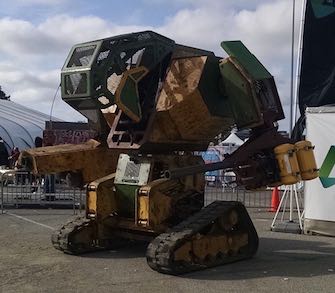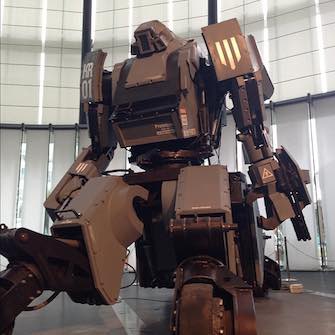In 2012, the global robotics industry saw a total of $26.8 billion in economic activity, according to Bloomberg Business. Much of this was focused in the field of heavy industrial robotics, as was pointed out in a video segment produced by the business news publisher, but robotics for consumers are expected to become a much larger sector in the next few years. Last year, we discussed many of the potential impacts of a more robust robotics industry, both for good and bad. Our series of corporate intellectual portfolio reviews, especially those involving South Korean-based Samsung Electronics, offers further proof that a more mechanized world is not too far around the corner.
Most recently, the mainstream news has picked up on an item of great interest to the robotic world. An American engineering firm known as MegaBot USA issued a challenge to Japanese-based Suidobashi Heavy Industry that would pit MegaBot’s six-ton Mark 2 giant robot into a battle against the Kuratas made by Suidobashi. In a response issued by Kogoro Kurata, CEO of Suidobashi and the designer of the Kuratas, there was some good-natured but thorough ribbing of MegaBot’s design. “Just building something huge and sticking guns on it, it’s super American,” Kurata said.
Fans of the 2013 major motion picture release Pacific Rim or the Gundam media franchise featuring giant robots, or mecha, would likely be greatly intrigued by the weapons systems available on either of these robots. It’s almost chilling to hear a Suidobashi representative call the weapon systems of the Kuratas “its greatest feature” in a training video, but with a six-barrel cannon and twin Gatling guns capable of firing 6,000 BB bullets per minute, it’s certainly an impressive aspect of the unit. Even more incredibly, the Gatling guns can be configured to fire when the Kuratas operator is smiling, a feature which has been dubbed smile shot command. As the training video cautions, “be careful not to cause a shooting spree by smiling too much!” The MegaBot Mark 2 shoots three-pound paintballs at speeds of 100 miles per hour, enough to do significant damage to an automobile.
The MegaBot Mark 2 robotic craft is operated by a two-man crew, whereas the Kuratas can be driven by a single operator. The Kuratas’s V-Sido software enables control of the robotic unit to a driver in the cockpit, through a master-slave control where the Kuratas mimics the way a much smaller model is manipulated by a user or through a smartphone over a 3G network. The Mark 2’s operational system requires one person to navigate the robotic unit’s motion while another operator acts as the gunner, swivelling the body to aim weapons before firing them.
The frenetic tizzy over the coming robot battle which has been worked up in some corners of the Internet will die down well before the match gets underway. The challenge issued by MegaBot USA comes with a one year timeline, which will allow both companies to fine-tune their models and make sure that they are as ready for combat as possible. Whenever the battle does come, though, you can bet there will be thousands clamoring to be spectators given the commercial success of mecha media like Pacific Rim (which flopped in America but actually wound up becoming the tenth-highest grossing film globally the year it was released).
Giant robots will not be sold to consumers any day soon. The weapons systems are a regulatory nightmare and costs per unit are pretty steep; the MegaBot Mark 2 costs about $175,000 to build but even that’s pretty cheap compared to the $1 million price tag of the Suidobashi Kuratas. Still, there are some organizations which are calling for greater investment into the application of robotic technologies into various consumer fields. Some, including New York Times economic columnist Paul Krugman, view robotics as a capital-intensive industry with negative implications for labor. Others have argued that robotics are actually capital efficient technologies which will become so profitable when successful that the technology practically demands to be commercialized.
In China, we’re seeing the early stages of a country which is welcoming the oncoming rush of robotics being developed around the world. The country is the largest market in the world for robotic machines as of early July and sales of robotics have been increasing in recent years in China. The robotics industry sold a total of 225,000 units during 2014 and the vast majority of those, greater than 50,000 units, went to China. Officials in Guangdong Province’s Foshan City have announced the building of a 20,000 square meter (about 215,000 square feet) supermarket complex in the city, almost four NFL football fields in size, where robotics will be retailed to consumers. The facility will also include factory space for robot designers and developers can program and build their own models for a wide degree of industrial applications, including automotive, machine tools and furniture fabrication. There will also be an intellectual property rights court situated on the premises so that developers can more easily assert their IP rights when infringed.
One interesting aspect of the current robotics industry is that even as robotics are becoming more heavily commercialized, the industry still seems to be largely dominated by individual makers and small firms. Both of the robot giants that are planning to go toe-to-toe next year aren’t being developed by large corporations but rather small firms run by the original designers of those units; of course, we’ve pointed out the issues of commercializing giant robot tech so it makes sense that corporate investment in this field would be weak. Samsung does have a huge presence in robotics, as we’ve noted above, but the maker presence at the Foshan City supermarket, replete with IPR courts, proves that the small individual maker is a strong presence in the field of robotics.
We tend to think of robots as having a human-like appearance but not every robotics unit having an impact across the globe is humanoid. Autonomous driving technologies, which we’ve been following closely this year on IPWatchdog, involve aspects of robotics to automate the manual work of driving a car. One robotics company will be releasing a series of robots designed for use in airports to keep the floors clean, help transport disabled passengers and even assist baggage handlers in lifting heavy loads. The manufacturer is Japanese but the founders must have enjoyed American movie culture (and may possess a dark sense of humor) because the company is named Cyberdyne, the same name as the manufacturer of the fictional Skynet from the Terminator motion picture series. Robotic software can also be designed to be highly cognitive and one company, Narrative Science Inc. of Chicago, is working to develop artificial intelligence which would mechanize the work of financial analysts by synthesizing data from quarterly earnings reports, internal documents and databases to make financial predictions.
____________________
For more information on the image license please see CC BY-SA 2.0.

![[IPWatchdog Logo]](https://ipwatchdog.com/wp-content/themes/IPWatchdog%20-%202023/assets/images/temp/logo-small@2x.png)



![[[Advertisement]]](https://ipwatchdog.com/wp-content/uploads/2024/04/Patent-Litigation-2024-banner-938x313-1.jpeg)
![[Advertisement]](https://ipwatchdog.com/wp-content/uploads/2024/04/Artificial-Intelligence-2024-REPLAY-sidebar-700x500-corrected.jpg)
![[Advertisement]](https://ipwatchdog.com/wp-content/uploads/2024/04/UnitedLex-May-2-2024-sidebar-700x500-1.jpg)
![[Advertisement]](https://ipwatchdog.com/wp-content/uploads/2024/04/Patent-Litigation-Masters-2024-sidebar-700x500-1.jpg)

![[Advertisement]](https://ipwatchdog.com/wp-content/uploads/2021/12/WEBINAR-336-x-280-px.png)
![[Advertisement]](https://ipwatchdog.com/wp-content/uploads/2021/12/2021-Patent-Practice-on-Demand-recorded-Feb-2021-336-x-280.jpg)
![[Advertisement]](https://ipwatchdog.com/wp-content/uploads/2021/12/Ad-4-The-Invent-Patent-System™.png)






Join the Discussion
No comments yet.